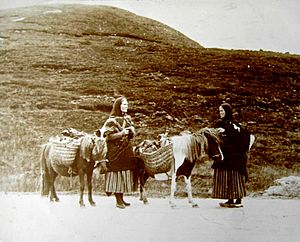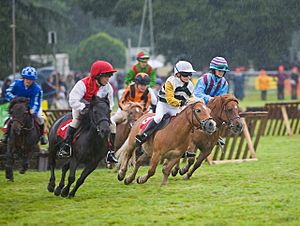Shetland pony facts for kids
 |
|
| Distinguishing features | Intelligent, small size, sturdy build, thick coat, compact and strong |
|---|---|
| Alternative names | Shetland |
| Country of origin | Shetland Islands, Scotland |
| Breed standards | |
| Shetland Pony Studbook Society | Breed standards |
| American Shetland Pony Club | Breed standards |
| Horse (Equus ferus caballus) | |
The Shetland pony is a small, strong type of pony that comes from the Shetland Islands in northern Scotland. These ponies are known for being very sturdy. They can stand up to about 107 centimeters (42 inches) tall at their shoulders. Shetland ponies have a thick, warm coat and short, powerful legs. They are used for many things, like riding, pulling carts, and carrying items.
Contents
History of Shetland Ponies
Where Shetland Ponies Came From
Shetland ponies first lived on the Shetland Islands. These islands are located northeast of mainland Scotland. Small horses have lived there since the Bronze Age. People on the islands likely bred these native horses with ponies brought by Norse settlers. The Celtic pony also influenced them. These ponies were brought to the islands between 2000 and 1000 BCE. The tough weather and limited food on the islands helped these ponies become very hardy.
Shetland Ponies at Work
Shetland ponies were first used to pull carts. They also carried things like peat and coal. They even helped to plough land on farms. During the Industrial Revolution, there was a big need for coal. Thousands of Shetland ponies were sent to mainland Britain. They worked underground in coal mines as pit ponies. These ponies often spent their whole lives hauling coal. Some were even sent to coal mines in the eastern United States. The last mine in the United States that used ponies closed in 1971.
Protecting the Breed
The Shetland Pony Stud-Book Society was started in 1890. Its goal is to keep the traditional Shetland pony breed pure. It also helps to encourage breeding high-quality animals. In 1957, a special plan was made to help improve breeding. This plan helped provide good male ponies for breeding. In the United States, ponies can also be registered with other clubs. These clubs help keep track of the breed.
Related Pony Breeds
Many other pony breeds have come from the traditional Shetland pony. These include the American Shetland Pony. Another is the Pony of the Americas in the United States. In Germany, there is also the Deutsches Classic Pony.
What Makes a Shetland Pony Special
Shetland ponies are very strong and tough. This is because they grew up in the harsh conditions of the Shetland Islands. They have a small head and eyes that are set wide apart. Their ears are small and always alert. They have a short, muscular neck and a strong, compact body. Their legs are short and powerful.
Shetland ponies have a broad back and a deep chest. They also have a springy way of walking. They have a long, thick mane and tail. Their winter coat is very dense and double-layered. This helps them stay warm in cold weather. Shetland ponies can be almost any horse color. The only color they usually are not is spotted. It is common for a Shetland pony to live for more than 30 years.
How Shetland Ponies Are Used Today
Today, children often ride Shetland ponies. Both children and adults show them at horse shows. They compete in classes where ponies pull carts. People also enjoy driving them for fun outside of shows. Small children ride Shetlands at horse shows and in riding schools. They are also used for fun rides.
Shetland ponies sometimes work at fairs or carnivals. They give short rides to visitors. You might also see them at petting zoos. Some are even used for therapeutic horseback riding. In the United Kingdom, Shetlands are part of the Shetland Pony Grand National. Young riders gallop them around a racecourse. A few Shetland ponies still do traditional work on the islands. They carry peat from the hillsides in large bags. Peat is used as a fuel source there. Their strong bodies help them cross difficult land. This makes them a good choice for the job, even today.
Junior Harness Racing
Junior Harness Racing was started in Queensland, Australia. It gives young people aged 6 to 16 a chance to learn about harness racing. Children can drive Shetland ponies in races. They do not win money in these races. However, winners and top finishers receive special medals.
Guide Ponies
Some miniature Shetland ponies have been trained as guide horses. They help people who are blind, just like guide dogs do. Other miniature horse breeds also perform this important task.
See also
 In Spanish: Poni de las Shetland para niños
In Spanish: Poni de las Shetland para niños





